OpsRamp was a sponsor of Gartner Symposium in Orlando last week, where CIOs and top executives gathered to share knowledge on the changing role of IT operations, DevOps adoption, and anything to do with cloud migration, monitoring, and management. Gartner analysts and researchers presented on several trends in the world of IT operations, and 10 of them offered key insights into the direction of our industry:
#1 - Growing Infrastructure and Operations Automation
Automation will become critical to everything within the enterprise, but strategic automation is the key. CEOs want growth rather than sheer efficiency. IT leaders should align automation strategy with business strategy. By 2025 more than 90% of enterprises will have an automation architect to manage and monitor automation so it evolves without causing an entirely new set of challenges and risks. See the Gartner note on the Automation Architect.
By 2025, more than 90% of enterprises will have an automation architect. #GartnerSYM
— Adam Martin (@colttrickle) October 21, 2019
#2 - Everything is Hybrid
Gartner focused on the impact of hybrid IT on disaster recovery strategy. From multi-cloud, to cloud native, to legacy enterprises looking to transform, it’s critical for IT operations teams to bridge the gap between legacy and modern workloads as they establish a new hybrid, multi-cloud digital infrastructure.
To bridge the gap and modernize your IT infrastructure a new hybrid, multi-cloud framework is required. @googlecloud #GartnerSym #ControltheChaos pic.twitter.com/CyTwXYhraQ
— Darren Cunningham (@dcunni) October 23, 2019
#3 - Scaling DevOps Agility
IT’s goal is to eventually become the program manager for DevOps teams and avoid creating individual silos, while dealing with increased complexity and potential overspending. Shared services platforms are the key to success.
#4 - Infrastructure is Everywhere and So Is Your Data
How can IT operations manage the onslaught of data from edge and IoT environments? Innovation starts with the business units, so it’s critical to understand how they’re generating and using data. Ultimately the pendulum swings back to enterprise IT to monitor and manage these silos of data. I attended a session later in the conference on shared-services best practices and the importance of offering both flexible and compliant enterprise infrastructure.Think ahead - shared services evolve from commodity to core business transformation. Don’t force all or nothing proposition. #gartnersym #ControltheChaos pic.twitter.com/t2spkh6P0D
— Darren Cunningham (@dcunni) October 22, 2019
#5 - IoT Realities
Internet of Things (IoT), with RFID tagging, edge computing, and distributed locations, are producing more data than ever before. With so many moving parts, IT operations teams need to be able to see the big picture. Standardization is a factor, but IT teams mustn’t be seen as taking things away from the business units and decentralized DevOps teams. Gartner recommended a Center of Excellence (CoE) approach to support business units and share best practices.
#6 - Distributed Cloud
At Symposium, Gartner announced its Top 10 Strategic Technology Trends for 2020, which included the growth of distributed cloud services. AWS Outposts, a managed service offering for running AWS technologies on-premises, is coming to the enterprise after it was first announced at re:Invent 2018. Google is promoting Anthos, a hybrid cloud platform. VMware has done a nice job of partnering with each of the cloud vendors to move workloads into different environments. Azure Stack is the most mature today (OpsRamp announced support here), but IT leaders still need to think about Day 2 operations. Who manages the monitoring and lifecycle management of this distributed environment?
#7 - Immersive Experience
Today’s technology must adapt to humans, not the other way around. AR, VR and immersive experiences were a bigger topic at last year’s conference. There’s an upside and a downside here for modern IT operations teams, as new technologies provide incredible opportunities, but also present new management challenges. Be prepared and have a plan as digital initiatives evolve in your enterprise.
#8 - The Democratization of IT
With low-code application development on the rise in business units, enterprise IT needs to manage and monitor many new services every day. It’s essential to establish a consistent toolset with the right governance framework in place to manage risk while facilitating the growth of new enabling technologies that businesspeople and developers want.#GartnerSYM Trend #8: Continued Democratization of IT - User-built solutions through Low-Code or No-Code platforms must be managed by IT which strains IT capacity even further.
— Patrick J Powers (@PowersPatrick) October 21, 2019
#9 - Networking
The most complex elements in the hybrid world often become the bottleneck. CIOs are looking at technologies like multi-cloud networking, Network as a Service (NaaS), Kubernetes networking (using Container Network Interfaces or CNI's), Firewall-as-a-Service (FWaaS), network automation, service mesh and more to improve performance and lower costs. Networking is not a new trend for IT operations teams, but the continual advancements in this area require a new set of skills and technologies.
#10 - Hybrid Digital Infrastructure Management (HDIM)
Gartner analyst David Cappuccio published a research note with fellow analyst Roger Williams on this topic, predicting that by 2022, 20% of enterprises will use hybrid digital infrastructure management tools to optimize workload placement across hybrid environments. The report (subscription required) features OpsRamp as a representative vendor.
Hybrid Digital Infrastructure Management (HDMI). Good overview from @davecapp - platform and business self-service approach required. #GartnerSym #ControltheChaos pic.twitter.com/kqHSMHbt7W
— Darren Cunningham (@dcunni) October 21, 2019
In short, modern IT operations teams must align with the business to drive strategic initiatives and decide between control and letting go in different circumstances.
Next Steps:
- Read the latest OpsRamp report: Adapt or Perish: The OpsRamp Report on Modern IT Operations in a Digital World.
- Connect with the OpsRamp team next week at the Gartner Symposium in Barcelona!
- Calculate the ROI of moving to the OpsRamp platform.
- Schedule a custom demonstration of the OpsRamp platform.






